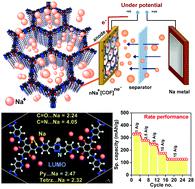当前位置:
X-MOL 学术
›
Nanoscale Horiz.
›
论文详情
Our official English website, www.x-mol.net, welcomes your
feedback! (Note: you will need to create a separate account there.)
Tuning the electronic energy level of covalent organic frameworks for crafting high-rate Na-ion battery anode.
Nanoscale Horizons ( IF 8.0 ) Pub Date : 2020-06-25 , DOI: 10.1039/d0nh00187b Sattwick Haldar 1 , Dhananjayan Kaleeswaran , Deepak Rase , Kingshuk Roy , Satishchandra Ogale , Ramanathan Vaidhyanathan
Nanoscale Horizons ( IF 8.0 ) Pub Date : 2020-06-25 , DOI: 10.1039/d0nh00187b Sattwick Haldar 1 , Dhananjayan Kaleeswaran , Deepak Rase , Kingshuk Roy , Satishchandra Ogale , Ramanathan Vaidhyanathan
Affiliation

|
Crystalline Covalent Organic Frameworks (COFs) possess ordered accessible nano-channels. When these channels are decorated with redox-active functional groups, they can serve as the anode in metal ion batteries (LIB and SIB). Though sodium's superior relative abundance makes it a better choice over lithium, the energetically unfavourable intercalation of the larger sodium ion makes it incompatible with the commercial graphite anodes used in Li-ion batteries. Also, their sluggish movement inside the electrodes restricts the fast sodiation of SIB. Creating an electronic driving force at the electrodes via chemical manipulation can be a versatile approach to overcome this issue. Herein, we present anodes for SIB drawn on three isostructural COFs with nearly the same Highest Occupied Molecular Orbitals (HOMO) levels but with varying Lowest Unoccupied Molecular Orbitals (LUMO) energy levels. This variation in the LUMO levels has been deliberately obtained by the inclusion of electron-deficient centers (phenyl vs. tetrazine vs. bispyridine-tetrazine) substituents into the modules that make up the COF. With the reduction in the cell-potential, the electrons accumulate in the anti-bonding LUMO. Now, these electron-dosed LUMO levels become efficient anodes for attracting the otherwise sluggish sodium ions from the electrolyte. Also, the intrinsic porosity of the COF favors the lodging and diffusion of the Na+ ions. Cells made with these COFs achieve a high specific capacity (energy density) and rate performance (rapid charging–discharging), something that is not as easy for Na+ compared to the much smaller sized Li+. The bispyridine-tetrazine COF with the lowest LUMO energy shows a specific capacity of 340 mA h g−1 at 1 A g−1 and 128 mA h g−1 at a high current density of 15 A g−1. Only a 24% drop appears on increasing the current density from 0.1 to 1 A g−1, which is the lowest among all the top-performing COF derived Na-ion battery anodes.
中文翻译:

调整共价有机骨架的电子能级,以制备高速率的Na离子电池阳极。
结晶共价有机框架(COF)具有有序可访问的纳米通道。当这些通道装饰有氧化还原活性官能团时,它们可以用作金属离子电池(LIB和SIB)中的阳极。尽管钠的相对丰度高,是比锂更好的选择,但较大的钠离子在能量上不利的嵌入使得它与锂离子电池中使用的商用石墨阳极不兼容。同样,它们在电极内部的缓慢运动限制了SIB的快速溶解。通过电极在电极上产生电子驱动力化学操作可以是克服此问题的通用方法。本文中,我们介绍了在三个等结构COF上绘制的SIB阳极,它们具有几乎相同的最高被占领分子轨道(HOMO)能级,但具有最低到最低分子轨道(LUMO)的能级。LUMO含量的这种变化是通过包含缺电子中心(苯基对四嗪对二甲苯)而有意获得的。双吡啶-四嗪)取代基插入组成COF的模块中。随着电池电位的降低,电子在反键LUMO中积累。现在,这些电子剂量的LUMO能级成为有效的阳极,可从电解质中吸引原本缓慢的钠离子。而且,COF的固有孔隙度有利于Na +离子的倒伏和扩散。用这些COF制成的电池具有很高的比容量(能量密度)和速率性能(快速充电-放电),与小得多的Li +相比,Na +并不那么容易。的双吡啶四嗪COF具有最低LUMO能显示340毫安Hg的比容量-1 1 A G -1和128毫安汞柱-1在15A g的高电流密度-1。在将电流密度从0.1 A g -1增加到1时,仅出现24%的下降,这在所有表现最佳的COF衍生的Na离子电池阳极中是最低的。
更新日期:2020-07-27
中文翻译:

调整共价有机骨架的电子能级,以制备高速率的Na离子电池阳极。
结晶共价有机框架(COF)具有有序可访问的纳米通道。当这些通道装饰有氧化还原活性官能团时,它们可以用作金属离子电池(LIB和SIB)中的阳极。尽管钠的相对丰度高,是比锂更好的选择,但较大的钠离子在能量上不利的嵌入使得它与锂离子电池中使用的商用石墨阳极不兼容。同样,它们在电极内部的缓慢运动限制了SIB的快速溶解。通过电极在电极上产生电子驱动力化学操作可以是克服此问题的通用方法。本文中,我们介绍了在三个等结构COF上绘制的SIB阳极,它们具有几乎相同的最高被占领分子轨道(HOMO)能级,但具有最低到最低分子轨道(LUMO)的能级。LUMO含量的这种变化是通过包含缺电子中心(苯基对四嗪对二甲苯)而有意获得的。双吡啶-四嗪)取代基插入组成COF的模块中。随着电池电位的降低,电子在反键LUMO中积累。现在,这些电子剂量的LUMO能级成为有效的阳极,可从电解质中吸引原本缓慢的钠离子。而且,COF的固有孔隙度有利于Na +离子的倒伏和扩散。用这些COF制成的电池具有很高的比容量(能量密度)和速率性能(快速充电-放电),与小得多的Li +相比,Na +并不那么容易。的双吡啶四嗪COF具有最低LUMO能显示340毫安Hg的比容量-1 1 A G -1和128毫安汞柱-1在15A g的高电流密度-1。在将电流密度从0.1 A g -1增加到1时,仅出现24%的下降,这在所有表现最佳的COF衍生的Na离子电池阳极中是最低的。











































 京公网安备 11010802027423号
京公网安备 11010802027423号